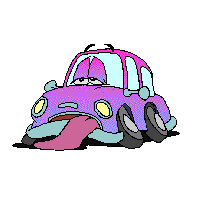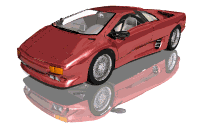|
Check whether the class you have selected
allows you to move the axle slots. Only the Open class allows you
to do this
For Open Class Only. It has been
discovered over the years that cars with a longer wheel-base can
be faster than shorter wheel-base cars. With this in mind you may
want to consider relocating the two axle slots in the car block
toward the ends of the block.
There are none so important as the wheels.
They must be mounted so they run free, track straight, and be
able to be lubricated. Don't paint your car with the wheels on.
If possible avoid putting the wheels on at all until you have
finished the painting.
You must ensure that the wheels roll
smoothly, in a straight line and roll very easily. There are
things to check and fix on each of the wheels. First, the wheels
must be perfectly round. Some moulds may produce slightly
out-of-round wheels which are slower than others. To check for
this put the wheel on an axle and spin it. It should turn with
the outside surface at a single reference point never varying.
The run-out or the wheel movement along the axle axis should also
be minimal. There isn't much you can do to correct a bad wheel.
The wheels are or much better quality in recent years and bad
wheels have been greatly reduced.
Check the wheel for burrs on the running
surface of the tire and hub areas. These need to be freed of any
extra plastic residue or moulding marks.
The nail type axles that come in the
Pinewood derby kit must be used in the construction of
your car. These provide no bearing surface so there is friction
between the plastic wheel surface and the metal axle. Since this
friction reduces speed we need to minimise the contact surface
area, make the surfaces smooth and lubricate the mating surfaces.
It is against the rules to machine the plastic wheel and these
procedures usually require a lathe or other tools. That still
leaves the axle open to "play with". The following
steps suggest things you can do with simple hand tolls to improve
the performance of the axles.
Axle Burr
Removal
First, the heads of the nails used as axles
in the kit will often have a old or casting mark in two places
just where the head attaches to the shaft the nail. Remove this
web of metal with a file being careful not to gouge or scratch
the running surface of the shaft. This will prevent the axle from
grinding the plastic hub area and slowing down your car. This is
usually best done with the axle chucked up in a drill press or
drill motor that is secured into a stable position.
Optional step. This step can be
performed before actual polishing but is designed for those
creating "the ultimate" racing machines. It's not
necessary for the average racer. Use a fine flat file to reduce
the overall diameter of the axle. To do this, chuck the pointed
end of the axle into a drill press or drill motor that has been
secured with a vice or clamp. Place the file against the rotating
axle and apply even pressure while moving the file slowly. Do
this until the area within 12mm of the head is smaller than the
rest of the axle body. The more metal that is removed the less
contact surface available to create friction. The drawback to
removing too much metal is that the axle becomes weaker and will
not tolerate being dropped or withstand rough handling without
bending. This is often a trial and error procedure with much
testing required to result in a fast turning wheel.
First-Surface
Polishing
The axle can be finished to a high lustre
by following the steps detailed here. First, mount the axle in
drill motor chuck exposing the head and the first 20mm of the
axle. Secure the drill so that it doesn't move. Now cut a piece
of 400-600 grit wet or dry sandpaper to a strip approximately
12mm wide and 10 to 15 mm in length. Wet the surface of the sand
paper with water or light machine oil, start the drill and loop
the sandpaper over the axle and pull the paper back and forth
like a shoe polish cloth. Work the paper until the metal is
smooth in the wheel running area (next to the head of the axle).
This usually takes about a minute for each axle. Now, using
either pumice paste or metal polish in a soft cloth (like a
tee-shirt), start the drill again and press the cloth and polish
compound into the axle with a slight movement back and forth.
This will also take about a minute. The finished axle will be
very smooth and bright in appearance
Lubrication
The type of lubrication is usually
restricted at most races to dry lubricants but there are great
advantages to using the right lubrication. By the same token
there is harm in using the wrong lubricate. First, we should
discuss what it's all about.
The wheel should turn on the dry axle
without any undo force but the friction between the two parts
will quickly act to slow it down. It's this friction that you
would like to eliminate. While we can't eliminate friction
completely it can certainly be reduced. An automobile uses steel
roller or ball bearings to reduce friction on its wheels but our
car isn't permitted to use them. We can only lubricate what we
already have. A lubricant is any agent that provides a reduction
of friction. While there are many types of lubricants many will
either not work on light-weight parts or are not formulated to
work with plastics. Petroleum products such as motor and
household oil may soften the plastic wheels. They could, after a
time, fail to turn at all. This is not the surprise you'd like on
race day. Other liquid or aerosol lubricants include a spray-on
Teflon, WD-40, CRC and 3 in1 oil.
The most common and successfully used
lubricants are the graphite formulations and Graphite-Moly
blends. They provide a very smooth plating of microscopic spheres
that greatly reduce rolling friction. Plain graphite is available
in hardware stores and some variety stores. When installing your
wheels fill the axle hole of the wheel while capping the other
side. Gently push the axle through the wheel. Do this several
times and spin the wheel to help distribute the graphite through
the running surface. A good test of the wheel, axle and the
lubrication is a spin test. While holding the wheel in the axle
in a horizontal position spin the wheel with a flick of your
finger. It should spin freely slowly coming to a stop after 20 to
30 seconds. If it didn't spin that long - take a close at your
wheel clearance, axle finish and lubrication. Correct the
problems then test them again.
|

![]()









